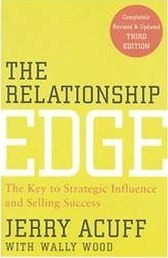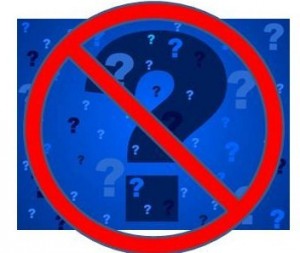 I first bought The Relationship Edge: The Key to Strategic Influence and Selling Success
I first bought The Relationship Edge: The Key to Strategic Influence and Selling Success out of curiosity, not expecting to find too much in it that would help me improve my sales or my clients’. In the ongoing debate about consultative selling vs. relationship selling, I’ve been pretty firmly in the consultative camp. To those who’ve said that relationships are everything, I’ve replied: “If you want a friend, get a dog.”
Intellectually, I guess I’ve wanted it to be true. After all, it seems to me that consultative selling is a meritocracy while relationship selling is a popularity contest. You truly have to know your stuff to make it to the top of CS, but it seems that any natural-born schmoozer and back-slapper can succeed at RS. Those of us on the introverted end of the scale tend to take offense at that.
On the other hand, why not work on being good and popular? When I look objectively at my own sales success, more opportunities have come my way from established relationships and referrals than from cold-calling. It’s much easier to be consultative when people are ready and willing to engage in a conversation, and relationships open the necessary doors.
Acuff’s book actually provides a bridge or middle ground between the two camps. On the one hand, he says that relationships are everything in business. His main premise is that the quality and the richness of our relationships determines in many ways the quality and richness of our lives. But then he spans the divide by adding that creating valuable business relationships is not about making friends, although often lasting friendships will result. It’s not just about making connections either. We all have hundreds of connections that will never turn into valuable business relationships.
What is a valuable business relationship? He begins by describing six levels of relationship, which he calls the Relationship Pyramid. At level 1, they don’t know who you are, and at level 6, you have a valuable business relationship, which he defines as those with AIR: Access, Impact and Results.
Access: will they take your calls and respond promptly to your emails?
Impact: You have an opportunity to influence their actions
Results: They do things proactively to help you succeed.
How do valuable business relationships help you sell? As Acuff says, when trust and rapport are strong, selling pressure will always seem weak; when trust and rapport are weak, any selling pressure will seem too strong.
All of us have a number of Level 6 relationships which have developed naturally in our work and personal lives. Acuff shows us how to implement a mindset and process to substantially increase our natural “hit rate” and grow the number of Level 6 relationships.
Mindset: You have to think that relationships are important, and that you have something of value to add to others. The paradox of building relationships is that you have to be genuinely interested in others as people—not as contacts or connections—and later the benefits will come. The best advice in the book is to envision that everyone you talk to has the following words tattooed on their forehead: “Make me feel important.”
Process: Mindset is useless without a process to develop relationships and to turn those relationships into measurable results. The process is pretty simple. First you list your most important relationships, assess where each one is on the pyramid, and then create a plan to move each relationship to higher levels. You do this by increasing your touches, learning more about them as people, taking actions that will make their lives better in some ways, etc.
To learn more about people, the book suggests a list of 20 questions. I don’t agree with all of them, and I won’t remember them all anyway, so the best thing to remember is FORM: Family, Occupation, Recreation, and Motivation. Of course, the danger with lists like this is that some people will become determined to get the answers from all their contacts and will go about it in a formulaic and self-defeating way. Acuff shares ways to ask the questions properly and weave them naturally into the conversation.
My own take after reading Acuff’s process is a bit different. The first thing I’ve done is turn the pyramid upside down, because it’s really a funnel. Just like a sales funnel, suspects enter at the top and closed deals emerge from the bottom, once they have gone through a codified and systematic selling/buying process. This way, you can set goals for new contacts to put in the funnel, have measurable events that will indicate objectively what the quality of a relationship is, and have goals for numbers of level 6 relationships created. At the moment, I am working through what the gates or milestones are at each level, and what are the best tactics for moving a relationship through the funnel.
The one weakness in the book is that it is a bit thin on some of this practical advice. For example, Acuff says you need goals, but his chapter on goal setting is basically the ABCs of SMART goals, with very little practical advice on what some specific goals should be, and what tactics are best at each stage. I would have loved to see a chapter entitled: “50 ways to move people up the pyramid.”
That said, everyone is different, and maybe it’s best that the reader is left to figure out specifics on his own. The important thing is to have the right mindset, make a plan to work through the process, and stick to it. The Relationship Edge can help you with the big picture, and you can fill in the colors that work best for you.




